

Compact Muon Solenoid
LHC, CERN
| CMS-BPH-15-009 ; CERN-EP-2020-188 | ||
| Angular analysis of the decay $\mathrm{B^{+}}\to {\mathrm{K}^{\ast}(892)^{+}} \mu^{+} \mu^{-}$ in proton-proton collisions at $\sqrt{s} = $ 8 TeV | ||
| CMS Collaboration | ||
| 27 October 2020 | ||
| JHEP 04 (2021) 124 | ||
| Abstract: Angular distributions of the decay $\mathrm{B^{+}}\to {\mathrm{K}^{\ast}(892)^{+}} \mu^{+} \mu^{-}$ are studied using events collected with the CMS detector in $\sqrt{s} = $ 8 TeV proton-proton collisions at the LHC, corresponding to an integrated luminosity of 20.0 fb$^{-1}$. The forward-backward asymmetry of the muons and the longitudinal polarization of the ${\mathrm{K}^{\ast}(892)^{+}}$ meson are determined as a function of the square of the dimuon invariant mass. These are the first results from this exclusive decay mode and are in agreement with a standard model prediction. | ||
| Links: e-print arXiv:2010.13968 [hep-ex] (PDF) ; CDS record ; inSPIRE record ; HepData record ; CADI line (restricted) ; | ||
| Figures | |

png pdf |
Figure 1:
Definition of the angular observables $\theta _{\mathrm{K}}$ (left), $\theta _{\ell}$ (middle), and $\phi $ (right) for the decay ${\mathrm{B^{+}} \to {\mathrm{K} ^{\ast +}} \mu^{+} \mu^{-}}$. |

png pdf |
Figure 2:
The signal efficiency as a function of $\cos\theta _\mathrm{K} $ (upper row) and $\cos\theta _\ell $ (lower row) from simulation for the ${q^2}$ ranges indicated. The vertical bars indicate the statistical uncertainty. The curves show the projection of the fitted result obtained from the two-dimensional fit, as described in the text. |

png pdf |
Figure 2-a:
The signal efficiency as a function of $\cos\theta _\mathrm{K} $ from simulation for the ${q^2}$ range indicated. The vertical bars indicate the statistical uncertainty. The curve shows the projection of the fitted result obtained from the two-dimensional fit, as described in the text. |
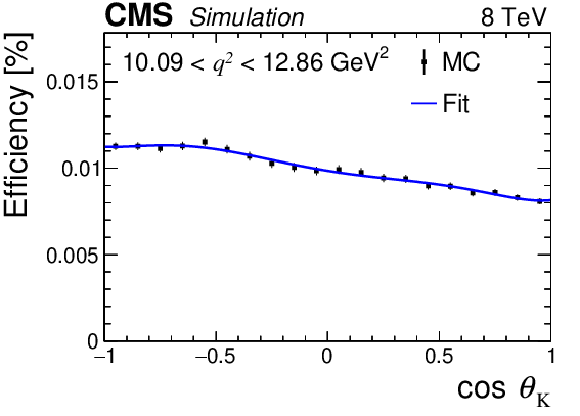
png pdf |
Figure 2-b:
The signal efficiency as a function of $\cos\theta _\mathrm{K} $ from simulation for the ${q^2}$ range indicated. The vertical bars indicate the statistical uncertainty. The curve shows the projection of the fitted result obtained from the two-dimensional fit, as described in the text. |

png pdf |
Figure 2-c:
The signal efficiency as a function of $\cos\theta _\mathrm{K} $ from simulation for the ${q^2}$ range indicated. The vertical bars indicate the statistical uncertainty. The curve shows the projection of the fitted result obtained from the two-dimensional fit, as described in the text. |
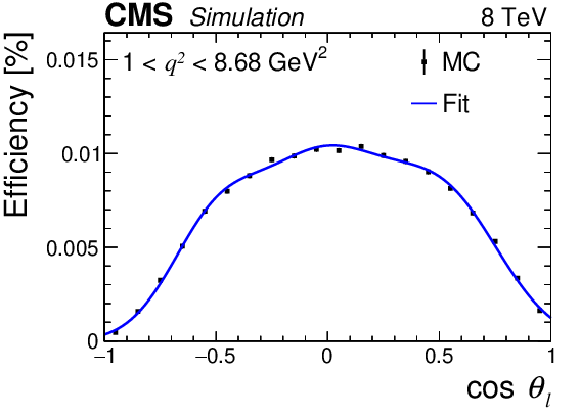
png pdf |
Figure 2-d:
The signal efficiency as a function of $\cos\theta _\ell $ from simulation for the ${q^2}$ range indicated. The vertical bars indicate the statistical uncertainty. The curve shows the projection of the fitted result obtained from the two-dimensional fit, as described in the text. |
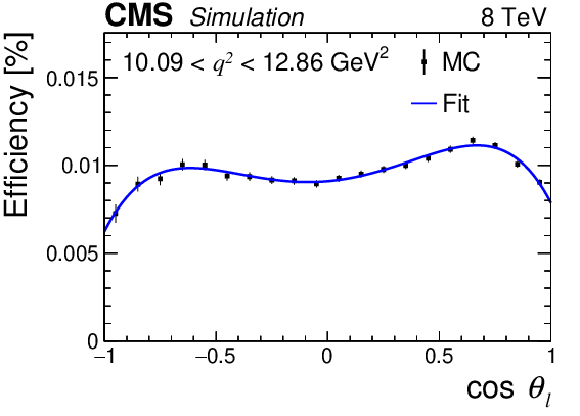
png pdf |
Figure 2-e:
The signal efficiency as a function of $\cos\theta _\ell $ from simulation for the ${q^2}$ range indicated. The vertical bars indicate the statistical uncertainty. The curve shows the projection of the fitted result obtained from the two-dimensional fit, as described in the text. |

png pdf |
Figure 2-f:
The signal efficiency as a function of $\cos\theta _\ell $ from simulation for the ${q^2}$ range indicated. The vertical bars indicate the statistical uncertainty. The curve shows the projection of the fitted result obtained from the two-dimensional fit, as described in the text. |

png pdf |
Figure 3:
The ${\mathrm{K^0_S}} \pi^{+} \mu^{+} \mu^{-} $ invariant mass (upper row), $\cos\theta _\mathrm{K} $ (middle row), and $\cos\theta _\ell $ (lower row) distributions for each ${q^2}$ range is shown for data, along with the fit projections. The vertical bars on the data points indicate the statistical uncertainty. The filled areas, dashed lines, and solid lines represent the signal, background, and total contributions, respectively. |

png pdf |
Figure 3-a:
The ${\mathrm{K^0_S}} \pi^{+} \mu^{+} \mu^{-} $ invariant mass distribution for the indeicated ${q^2}$ range is shown for data, along with the fit projections. The vertical bars on the data points indicate the statistical uncertainty. The filled area, dashed line, and solid line represent the signal, background, and total contributions, respectively. |
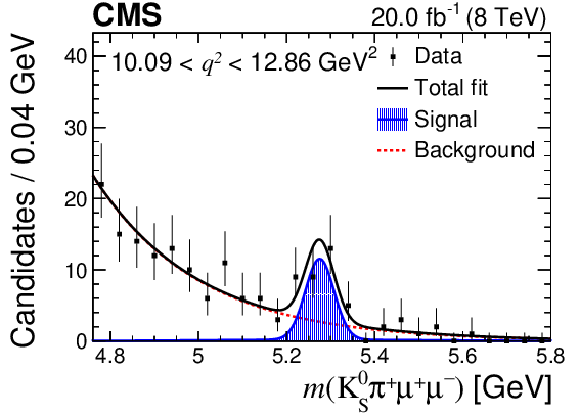
png pdf |
Figure 3-b:
The ${\mathrm{K^0_S}} \pi^{+} \mu^{+} \mu^{-} $ invariant mass distribution for the indeicated ${q^2}$ range is shown for data, along with the fit projections. The vertical bars on the data points indicate the statistical uncertainty. The filled area, dashed line, and solid line represent the signal, background, and total contributions, respectively. |

png pdf |
Figure 3-c:
The ${\mathrm{K^0_S}} \pi^{+} \mu^{+} \mu^{-} $ invariant mass distribution for the indeicated ${q^2}$ range is shown for data, along with the fit projections. The vertical bars on the data points indicate the statistical uncertainty. The filled area, dashed line, and solid line represent the signal, background, and total contributions, respectively. |

png pdf |
Figure 3-d:
The ${\mathrm{K^0_S}} \pi^{+} \mu^{+} \mu^{-} $ $\cos\theta _\mathrm{K} $ distribution for the indeicated ${q^2}$ range is shown for data, along with the fit projections. The vertical bars on the data points indicate the statistical uncertainty. The filled area, dashed line, and solid line represent the signal, background, and total contributions, respectively. |

png pdf |
Figure 3-e:
The ${\mathrm{K^0_S}} \pi^{+} \mu^{+} \mu^{-} $ $\cos\theta _\mathrm{K} $ distribution for the indeicated ${q^2}$ range is shown for data, along with the fit projections. The vertical bars on the data points indicate the statistical uncertainty. The filled area, dashed line, and solid line represent the signal, background, and total contributions, respectively. |

png pdf |
Figure 3-f:
The ${\mathrm{K^0_S}} \pi^{+} \mu^{+} \mu^{-} $ $\cos\theta _\mathrm{K} $ distribution for the indeicated ${q^2}$ range is shown for data, along with the fit projections. The vertical bars on the data points indicate the statistical uncertainty. The filled area, dashed line, and solid line represent the signal, background, and total contributions, respectively. |
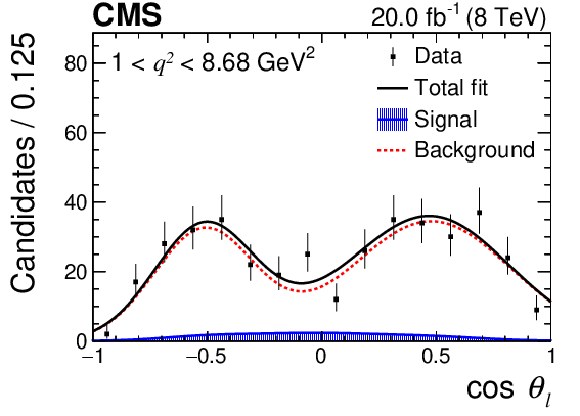
png pdf |
Figure 3-g:
The ${\mathrm{K^0_S}} \pi^{+} \mu^{+} \mu^{-} $ $\cos\theta _\ell $ distribution for the indeicated ${q^2}$ range is shown for data, along with the fit projections. The vertical bars on the data points indicate the statistical uncertainty. The filled area, dashed line, and solid line represent the signal, background, and total contributions, respectively. |

png pdf |
Figure 3-h:
The ${\mathrm{K^0_S}} \pi^{+} \mu^{+} \mu^{-} $ $\cos\theta _\ell $ distribution for the indeicated ${q^2}$ range is shown for data, along with the fit projections. The vertical bars on the data points indicate the statistical uncertainty. The filled area, dashed line, and solid line represent the signal, background, and total contributions, respectively. |

png pdf |
Figure 3-i:
The ${\mathrm{K^0_S}} \pi^{+} \mu^{+} \mu^{-} $ $\cos\theta _\ell $ distribution for the indeicated ${q^2}$ range is shown for data, along with the fit projections. The vertical bars on the data points indicate the statistical uncertainty. The filled area, dashed line, and solid line represent the signal, background, and total contributions, respectively. |

png pdf |
Figure 4:
The $\cos\theta _\mathrm{K} $ (upper row) and $\cos\theta _\ell $ (lower row) distributions for each ${q^2}$ range is shown for data in the invariant mass region 5.18 $ < m < $ 5.38 GeV, along with the fit projections for the same region. The vertical bars on the data points indicate the statistical uncertainty. The filled areas, dashed lines, and solid lines represent the signal, background, and total contributions, respectively. |

png pdf |
Figure 4-a:
The $\cos\theta _\mathrm{K} $ distribution for the indicated ${q^2}$ range is shown for data in the invariant mass region 5.18 $ < m < $ 5.38 GeV, along with the fit projections for the same region. The vertical bars on the data points indicate the statistical uncertainty. The filled area, dashed line, and solid line represent the signal, background, and total contributions, respectively. |

png pdf |
Figure 4-b:
The $\cos\theta _\mathrm{K} $ distribution for the indicated ${q^2}$ range is shown for data in the invariant mass region 5.18 $ < m < $ 5.38 GeV, along with the fit projections for the same region. The vertical bars on the data points indicate the statistical uncertainty. The filled area, dashed line, and solid line represent the signal, background, and total contributions, respectively. |

png pdf |
Figure 4-c:
The $\cos\theta _\mathrm{K} $ distribution for the indicated ${q^2}$ range is shown for data in the invariant mass region 5.18 $ < m < $ 5.38 GeV, along with the fit projections for the same region. The vertical bars on the data points indicate the statistical uncertainty. The filled area, dashed line, and solid line represent the signal, background, and total contributions, respectively. |
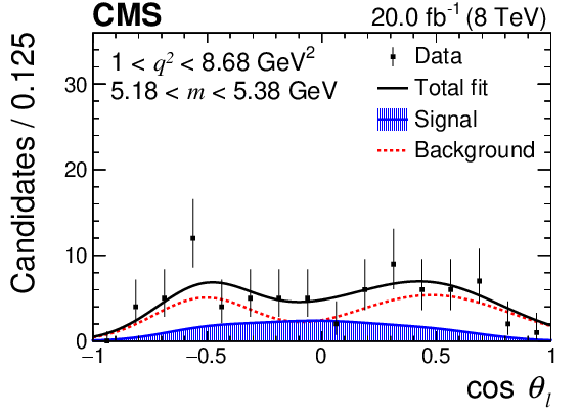
png pdf |
Figure 4-d:
The $\cos\theta _\ell $ distribution for the indicated ${q^2}$ range is shown for data in the invariant mass region 5.18 $ < m < $ 5.38 GeV, along with the fit projections for the same region. The vertical bars on the data points indicate the statistical uncertainty. The filled area, dashed line, and solid line represent the signal, background, and total contributions, respectively. |

png pdf |
Figure 4-e:
The $\cos\theta _\ell $ distribution for the indicated ${q^2}$ range is shown for data in the invariant mass region 5.18 $ < m < $ 5.38 GeV, along with the fit projections for the same region. The vertical bars on the data points indicate the statistical uncertainty. The filled area, dashed line, and solid line represent the signal, background, and total contributions, respectively. |
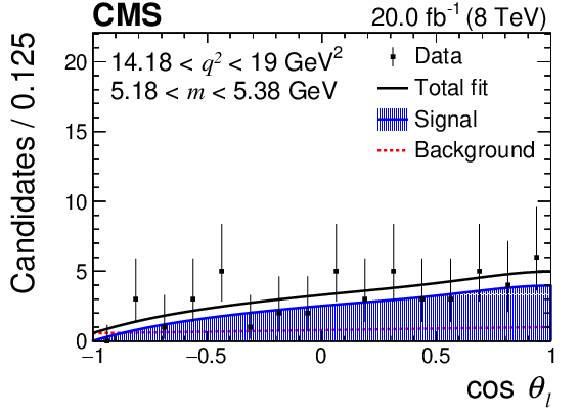
png pdf |
Figure 4-f:
The $\cos\theta _\ell $ distribution for the indicated ${q^2}$ range is shown for data in the invariant mass region 5.18 $ < m < $ 5.38 GeV, along with the fit projections for the same region. The vertical bars on the data points indicate the statistical uncertainty. The filled area, dashed line, and solid line represent the signal, background, and total contributions, respectively. |

png pdf |
Figure 5:
The measured values of ${A_\mathrm {FB}}$ (left) and ${F_\mathrm {L}}$ (right) versus ${q^2}$ for ${\mathrm{B^{+}} \to {\mathrm{K} ^{\ast +}} \mu^{+} \mu^{-}}$ decays are shown with filled squares, centered on the ${q^2}$ bin. The statistical (total) uncertainty is shown by inner (outer) vertical bars. The vertical shaded regions correspond to the regions dominated by ${\mathrm{B^{+}} \to {\mathrm{K} ^{\ast +}} {\mathrm{J}/\psi}}$ and ${\mathrm{B^{+}} \to {\mathrm{K} ^{\ast +}} \psi(\text{2S}})$ decays. The SM predictions and associated uncertainties are shown by the filled circles and vertical bars, with the points slightly offset from the center of the ${q^2}$ bin for clarity. |

png pdf |
Figure 5-a:
The measured values of ${A_\mathrm {FB}}$ versus ${q^2}$ for ${\mathrm{B^{+}} \to {\mathrm{K} ^{\ast +}} \mu^{+} \mu^{-}}$ decays are shown with filled squares, centered on the ${q^2}$ bin. The statistical (total) uncertainty is shown by inner (outer) vertical bars. The vertical shaded regions correspond to the regions dominated by ${\mathrm{B^{+}} \to {\mathrm{K} ^{\ast +}} {\mathrm{J}/\psi}}$ and ${\mathrm{B^{+}} \to {\mathrm{K} ^{\ast +}} \psi(\text{2S}})$ decays. The SM predictions and associated uncertainties are shown by the filled circles and vertical bars, with the points slightly offset from the center of the ${q^2}$ bin for clarity. |
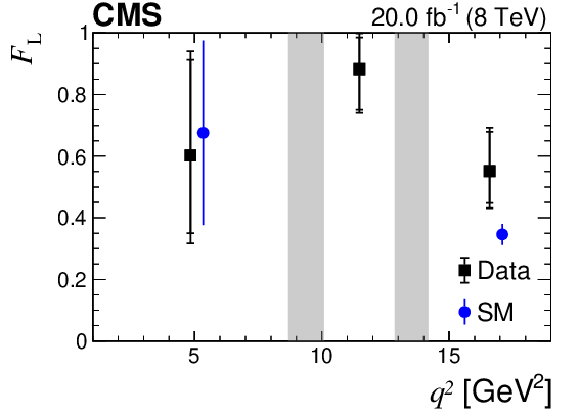
png pdf |
Figure 5-b:
The measured values of ${F_\mathrm {L}}$ versus ${q^2}$ for ${\mathrm{B^{+}} \to {\mathrm{K} ^{\ast +}} \mu^{+} \mu^{-}}$ decays are shown with filled squares, centered on the ${q^2}$ bin. The statistical (total) uncertainty is shown by inner (outer) vertical bars. The vertical shaded regions correspond to the regions dominated by ${\mathrm{B^{+}} \to {\mathrm{K} ^{\ast +}} {\mathrm{J}/\psi}}$ and ${\mathrm{B^{+}} \to {\mathrm{K} ^{\ast +}} \psi(\text{2S}})$ decays. The SM predictions and associated uncertainties are shown by the filled circles and vertical bars, with the points slightly offset from the center of the ${q^2}$ bin for clarity. |
| Tables | |

png pdf |
Table 1:
Sources of systematic uncertainties and the effect on ${A_\mathrm {FB}}$ and ${F_\mathrm {L}}$. The values given are absolute and the ranges indicate the variation over the ${q^2}$ bins. |

png pdf |
Table 2:
The $Y_S$, ${A_\mathrm {FB}}$, and ${F_\mathrm {L}}$ values from the fit for each ${q^2}$ range. The first uncertainty is statistical and the second is systematic. |
| Summary |
| The first angular analysis of the exclusive decay $\mathrm{B^{+}}\to {\mathrm{K}^{\ast}(892)^{+}} \mu^{+} \mu^{-}$, including the charge-conjugate state, has been performed using a sample of proton-proton collisions at a center-of-mass energy of 8 TeV. The data were collected with the CMS detector in 2012 at the LHC, and correspond to an integrated luminosity of 20.0 fb$^{-1}$. For each bin of the dimuon invariant mass squared (${q^2} $), a three-dimensional unbinned maximum likelihood fit is performed on the distributions of the ${\mathrm{K^{\ast}(892)}}(892)^{+}\mu^{+}\mu^{-}$ invariant mass and two decay angles. The muon forward-backward asymmetry, ${A_\mathrm{FB}} $, and the ${\mathrm{K}^{\ast}(892)^{+}} $ longitudinal polarization fraction, ${F_\mathrm{L}} $, are extracted from the fit in bins of ${q^2}$ and found to be consistent with a standard model prediction. |
| References | ||||
| 1 | CMS Collaboration | CMS luminosity based on pixel cluster counting -- summer 2013 update | CMS-PAS-LUM-13-001 | CMS-PAS-LUM-13-001 |
| 2 | CDF Collaboration | Measurements of the angular distributions in the decays $ \mathrm{B} \to \mathrm{K}^{(*)} \mu^+ \mu^- $ at CDF | PRL 108 (2012) 081807 | 1108.0695 |
| 3 | LHCb Collaboration | Differential branching fraction and angular analysis of the decay $ \mathrm{B}^{0} \to \mathrm{K}^{*0} \mu^{+}\mu^{-} $ | JHEP 08 (2013) 131 | 1304.6325 |
| 4 | CMS Collaboration | Angular analysis and branching fraction measurement of the decay $ \mathrm{B}^0 \to \mathrm{K}^{*0} \mu^+\mu^- $ | PLB 727 (2013) 77 | CMS-BPH-11-009 1308.3409 |
| 5 | CMS Collaboration | Angular analysis of the decay $ \mathrm{B}^0 \to \mathrm{K}^{*0} \mu^+ \mu^- $ from pp collisions at $ \sqrt{s} = $ 8 TeV | PLB 753 (2016) 424 | CMS-BPH-13-010 1507.08126 |
| 6 | BaBar Collaboration | Angular distributions in the decay $ \mathrm{B} \to \mathrm{K}^* \ell^+ \ell^- $ | PRD 79 (2009) 031102 | 0804.4412 |
| 7 | Belle Collaboration | Measurement of the differential branching fraction and forward-backward asymmetry for $ \mathrm{B} \to \mathrm{K}^{(*)} \ell^+ \ell^- $ | PRL 103 (2009) 171801 | 0904.0770 |
| 8 | C. Bobeth, G. Hiller, and D. van Dyk | The benefits of $ \overline{\mathrm{B}} \to \overline{\mathrm{K}}^{*} \ell^+ \ell^- $ decays at low recoil | JHEP 07 (2010) 098 | 1006.5013 |
| 9 | C. Bobeth, G. Hiller, D. van Dyk, and C. Wacker | The decay $ \overline{\mathrm{B}} \to \overline{\mathrm{K}} \ell^+ \ell^- $ at low hadronic recoil and model-independent $ \Delta B = $ 1 constraints | JHEP 01 (2012) 107 | 1111.2558 |
| 10 | C. Bobeth, G. Hiller, and D. van Dyk | General analysis of $ \overline{\mathrm{B}} \to \overline{\mathrm{K}}{}^{(*)} \ell^+ \ell^- $ decays at low recoil | PRD 87 (2012) 034016 | 1212.2321 |
| 11 | A. Ali, G. Kramer, and G. Zhu | $ \mathrm{B}\to \mathrm{K}^*\ell^+\ell^- $ decay in soft-collinear effective theory | EPJC 47 (2006) 625 | hep-ph/0601034 |
| 12 | W. Altmannshofer et al. | Symmetries and asymmetries of $ \mathrm{B} \to \mathrm{K}^{*} \mu^{+} \mu^{-} $ decays in the standard model and beyond | JHEP 01 (2009) 019 | 0811.1214 |
| 13 | W. Altmannshofer, P. Paradisi, and D. M. Straub | Model-independent constraints on new physics in $ b \to s $ transitions | JHEP 04 (2012) 008 | 1111.1257 |
| 14 | S. Jager and J. Martin Camalich | On $ \mathrm{B} \to \mathrm{V} \ell \ell $ at small dilepton invariant mass, power corrections, and new physics | JHEP 05 (2013) 043 | 1212.2263 |
| 15 | S. Descotes-Genon, T. Hurth, J. Matias, and J. Virto | Optimizing the basis of $ \mathrm{B} \to \mathrm{K}^{*}\ell^+ \ell^- $ observables in the full kinematic range | JHEP 05 (2013) 137 | 1303.5794 |
| 16 | S. Descotes-Genon, L. Hofer, J. Matias, and J. Virto | On the impact of power corrections in the prediction of $ \mathrm{B} \to \mathrm{K}^*\mu^+\mu^- $ observables | JHEP 12 (2014) 125 | 1407.8526 |
| 17 | M. Alguer\'o et al. | Are we overlooking lepton flavour universal new physics in $ b\to s\ell\ell $? | PRD 99 (2019) 075017 | 1809.08447 |
| 18 | M. Alguer\'o et al. | Emerging patterns of new physics with and without lepton flavour universal contributions | EPJC 79 (2019) 714 | 1903.09578 |
| 19 | CMS Collaboration | Description and performance of track and primary-vertex reconstruction with the CMS tracker | JINST 9 (2014) P10009 | CMS-TRK-11-001 1405.6569 |
| 20 | CMS Collaboration | The CMS experiment at the CERN LHC | JINST 3 (2008) S08004 | CMS-00-001 |
| 21 | CMS Collaboration | The CMS trigger system | JINST 12 (2017) P01020 | CMS-TRG-12-001 1609.02366 |
| 22 | CMS Collaboration | Performance of CMS muon reconstruction in pp collision events at $ \sqrt{s}= $ 7 TeV | JINST 7 (2012) P10002 | CMS-MUO-10-004 1206.4071 |
| 23 | Particle Data Group, P. A. Zyla et al. | Review of particle physics | Prog. Theor. Exp. Phys. 2020 (2020) 083C01 | |
| 24 | T. Sjostrand, S. Mrenna, and P. Skands | PYTHIA 6.4 physics and manual | JHEP 05 (2006) 026 | hep-ph/0603175 |
| 25 | D. J. Lange | The EvtGen particle decay simulation package | NIMA 462 (2001) 152 | |
| 26 | GEANT4 Collaboration | GEANT4 -- a simulation toolkit | NIMA 506 (2003) 250 | |
| 27 | D. Bečirević and A. Tayduganov | Impact of $ \mathrm{B}\to \mathrm{K}^{*0} \ell^+\ell^- $ on the new physics search in $ \mathrm{B}\to \mathrm{K}^* \ell^+\ell^- $ decay | NPB 868 (2013) 368 | 1207.4004 |
| 28 | J. Matias | On the $ S $-wave pollution of $ \mathrm{B} \to \mathrm{K}^* \ell^+\ell^- $ observables | PRD 86 (2012) 094024 | 1209.1525 |
| 29 | T. Blake, U. Egede, and A. Shires | The effect of $ S $-wave interference on the $ \mathrm{B}^0 \rightarrow \mathrm{K}^{*0} \ell^+ \ell^- $ angular observables | JHEP 03 (2013) 027 | 1210.5279 |
| 30 | G. J. Feldman and R. D. Cousins | Unified approach to the classical statistical analysis of small signals | PRD 57 (1998) 3873 | physics/9711021 |

|
Compact Muon Solenoid LHC, CERN |

|

|

|

|

|

|